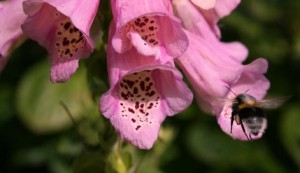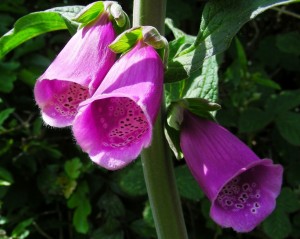 Foxgloves
Foxgloves
Faery gloves
Faery caps and bells –
Foxgloves are the Folks’ Gloves,
the Good Folk, that is,
and you’d better not forget it if you think to cut them down.
In the Faery Glen
on the Isle of Skye,
foxgloves stand like watchful sentinels of the Hidden People.
On Highland hillsides they march in crimson,
like the hosts of trooping faeries.
In Ireland’s wooded hollows,
glowing purple in the dusk,
foxglove is the lus na mban sidhe,
the Plant of the Faery Woman.
In Donegal, the blossoms are meíríní púca, Puck’s fingers,
or méaracan sídhe, Shilly Thimbles, Thimbles of the Sídhe.
When a foxglove bows its head, a faery is passing by.
Faeries have been seen dancing beneath them in the Welsh Marches, not so long ago.
And in Ireland, according to a story told to Yeats, they often hide under the leaves
where the casual observer mistakes their red caps for the crimson bells.
 Foxgloves are also called bee-catchers and beehives in the West Country.
Foxgloves are also called bee-catchers and beehives in the West Country.
It is said that the path of brown and white spots on the floor of each bell are
the marks of elven fingers,
designed to lead the bee towards the nectar.
Whoever was responsible,
foxgloves have certainly been designed
with the foraging bee in mind.
Each bell has a projecting lower lip for a landing pad,
from which the bee can proceed down the illuminated runway.
The anthers of the stamens lie flat along the inside “roof” of the bell
so that its pollen rubs off on the bee’s back.
The bee then transfers the pollen to the next flower enabling it to produce seeds:
1 to 2 million from each plant.
 Foxgloves have a darker side:
Foxgloves have a darker side:
They belong to the dead
whose blood and bones make fertile soil.
So their blossoms are also
Dead Man’s Thimbles,
Dead Man’s Bellows, (the phallus)
or, in Scotland, ciochan nan cailleachan marblia:
Dead old woman’s paps.
In Wales they are Dead Men’s Bells.
If you hear them ringing, you will not be long for this world.
 Meddle with a foxglove
Meddle with a foxglove
and you may become faery-struck.
Yet it can also cure any misfortune caused by the faeries.
If a child is Taken and a squalling changeling left in its place,
place foxglove leaves beneath its crib.
The faeries will bring back the stolen child.
In Ireland it is lus-mor, the Great Plant,
because of its healing virtues.
And in Wales it was one of the healing herbs
taught by the faery woman of Llyn y Fan Fach to her half-human sons,
who became the famous Physicians of Myddfai. Here foxgloves are bysedd ellyllon, Fingers of the Elves.
Foxgloves are also Witches’ Fingers,
once prized by the wise women of old,
for the treatment of sores, ulcers and wounds, and all manner of ills
from the common cold to the King’s Evil,
but especially in the treatment of heart conditions.
It was a wise woman of Shropshire who taught one Dr. Withering
how to use it for cardiac complaints in the 18th century.
Today foxgloves are cultivated on huge farms in the eastern United States
solely for medicinal purposes.
Digitalis, its botanical name, means “fingers.”
Whose fingers?
Foxgloves by Mary Webb
The foxglove bells, with lolling tongue,
Will not reveal what peals were rung
In Faery, in Faery,
A thousand ages gone.
All the golden clappers hang
As if but now the changes rang;
Only from the mottled throat
Never any echoes float.
Quite forgotten, in the wood,
Pale, crowded steeples rise;
All the time that they have stood
None has heard their melodies.
Deep, deep in wizardry
All the foxglove belfries stand.
Should they startle over the land,
None would know what bells they be.
Never any wind can ring them,
Nor the great black bees that swing them–
Every crimson bell, down-slanted,
Is so utterly enchanted.







Hi Mara! Met you at Bards and Harps at John’s. Lovely words on the beautiful Foxglove. They have been playing a blinder this year…despite the year.
Hi, Bridget – yes, what a grand time we had that weekend! some of the foxgloves in my garden are now 8 feet tall, what with all the rain we’ve been having. . . Giant foxgloves stalking the land . . .
hi Mara, lovely post with poetry and pics! I loved all the Foxgloves I would see while walking in England, a prized flower in my garden (NY) but so common there.
I LOVE Foxglove! I am in AZ and its about 115 degrees but I still have one foxglove living! I remember as a child, seeing these flowers and thinking they were the prettiest ever!
Hi Mary,
I was lucky enough to find that poem by an obscure Shropshire poet, Mary Webb. Her poems are full of the beauty of her life in nature in the early 20th century, and she clearly had some faery vision also. I may share some more of her poems here in future.
Hi Mara, lovely post, I am from the US transplanted to the West Country, do you buy foxglove seeds and sow – is this the best way? I would like some in my garden here!
Hello String,
The countryside is full of the pinky-purple wild ones, but you can buy seeds for lovely pastel shades, such as some of the ones pictured here. It’s best to sow them in a tray in the late spring and transplant them into thir final position in the autumn. You might be able to sow them now where you live – it may be warmer than Wales. They do self-seed, so although the major display will be the first year, they can pop up in subsequent years in all sorts of places!
Hello Mara, such a beautiful post on the most beloved Foxglove! Thank you. I live in Australia and unfortunately foxgloves are not very common but I have managed to grow one and hope fully this coming season more will bloom….. The first time I saw one was in a nursery, straight away I fell in love with this most amazing flower.
Thank you Foxglove,
Your namesake flower is very prolific with its seeds, so I hope you soon have many more!
Fascinating post Mara. Thanks. Love the Mary Webb poem – even more impressed that you’ve come across her! In Herefordshire and Worcestershire Foxgloves are called a mix of either Fairygloves, Fairy Hats, Fairy’s Thimbles, Fairy’s Petticoats or Lady’s Fingers! If a fairy wears foxgloves as gloves the story is that they can fully control and even kill a human……yikes!
Thanks, N!
Yes, MW was a recent delightful discovery, and I may post more of her poems in future. . . Your local faery lore sounds like the makings of a goth horror flick to me!